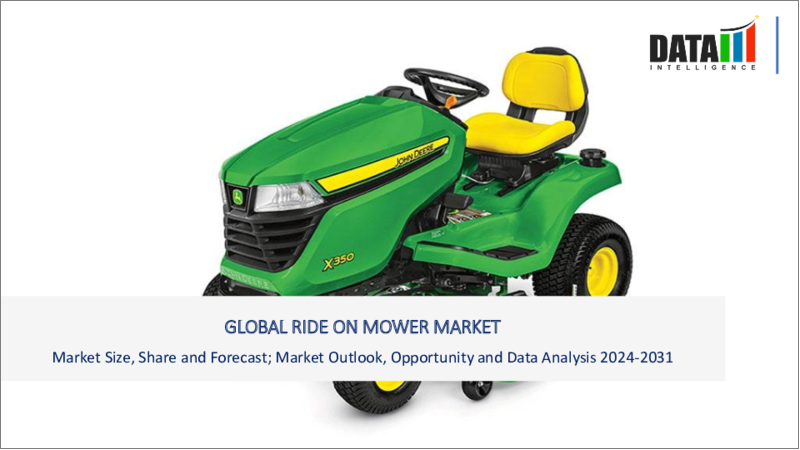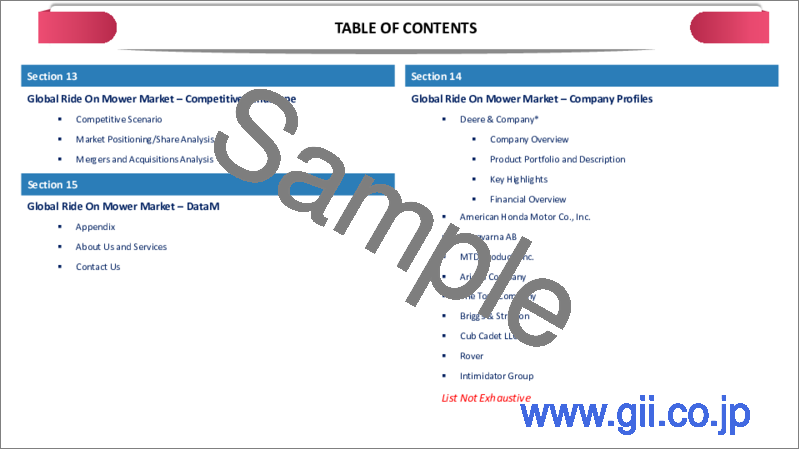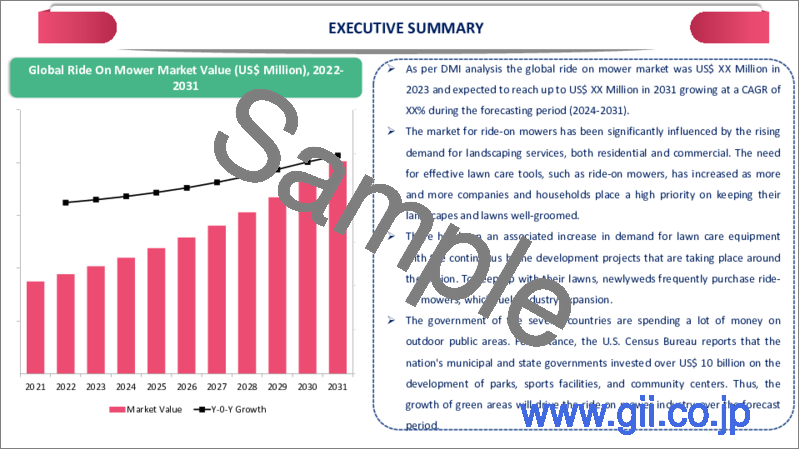|
|
市場調査レポート
商品コード
1447997
乗用芝刈機市場-2023年~2030年Ride On Mower Market - 2023-2030 |
||||||
カスタマイズ可能
適宜更新あり
|
|||||||
| 乗用芝刈機市場-2023年~2030年 |
|
出版日: 2024年03月08日
発行: DataM Intelligence
ページ情報: 英文 213 Pages
納期: 即日から翌営業日
|
- 全表示
- 概要
- 目次
概要
乗用芝刈機の世界市場は、2022年に38億米ドルに達し、2023年から2030年の予測期間にCAGR 4.3%で成長し、2030年には53億2,000万米ドルに達すると予測されます。
電動式乗用芝刈機への動向の高まりは、環境意識の高まりと規制圧力に後押しされています。消費者は従来のガソリン式芝刈り機に代わる環境に優しいものを求めるようになっており、メーカー各社はバッテリー技術の向上、運転時間の延長、排出ガスの削減を実現した電動モデルの開発に取り組んでいます。この動向は、各国政府がより厳しい排出ガス規制を実施し、消費者が購入の意思決定において持続可能性を優先するにつれて加速すると予想されます。
新興国市場でも、メーカー各社が新製品の開発を通じて消費者の需要に応えています。例えば、ホンダは2023年10月22日、自律走行機能を備えた電動乗用芝刈機を発表しました。Honda Autonomous Work Mower」と名付けられたこのプロトタイプは、米国ケンタッキー州で開催予定の2023 Equip Exposition power equipment conventionで一般初公開されます。
ゼロターン芝刈り機は、その優れた操縦性、効率性、狭いスペースを移動する能力により、北米で人気を集めています。消費者は、特に広い芝生や商業用途において、ゼロターン芝刈り機が提供する生産性の向上と時間の節約を高く評価しています。この動向は、従来の芝生トラクターよりも好まれるようになっているゼロターンモデルの市場成長を後押ししています。
市場力学
造園サービスの需要拡大
住宅の芝生、公園、スポーツフィールド、商業用景観など、屋外の生活空間に対する評価の高まりは、造園サービスに対する需要の高まりにつながっています。都市に住む人々は、これらのスペースを手作業で維持する時間や専門知識を持たないことが多いため、乗用芝刈機を備えた造園サービス業者が専門的な芝生手入れサービスの需要に応える機会が生まれています。
乗用芝刈機は、ゴルフコース、市営公園、スポーツ施設、業界情勢などの商業用造園用途で一般的に使用されています。商業施設は、その魅力を高め、広大な芝生を効率的に維持しようとするため、商業分野における乗用芝刈機の需要は堅調に伸びると予想されます。乗用芝刈機市場は、性能、効率、使い勝手の向上を目指した技術の進歩が続いています。
例えば、2023年4月11日、ハスクバーナ・グループは、同社の商用ラインアップに最新の新製品、Z560LSを発表しました。38.5馬力のカワサキFX1000 EFIエンジンを搭載したこの草刈機は、卓越した性能を発揮し、最も厳しい条件下でも最高品質の仕上がりを約束します。
消費者の電動草刈機へのシフト
環境問題への意識の高まりとともに、消費者は従来のガソリン式草刈機に代わる、環境に優しい草刈機を求めるようになっています。電動式乗用芝刈機は、よりクリーンで静かな作業を実現し、使用中の排出ガスもゼロです。これは、カーボンフットプリントを削減し、環境への影響を最小限に抑えたいという消費者の願望と一致し、市場における電動モデルの需要を牽引しています。
バッテリー技術の進歩により、電動芝刈機の性能と効率が向上しています。特にリチウムイオンバッテリーは、従来の鉛バッテリーに比べ、走行時間が長く、充電が速く、寿命が長いです。こうした進歩は、バッテリーの寿命や性能に関する懸念に対処することで電動草刈機の魅力を高め、市場に対する消費者の信頼を高めています。
例えば、2023年6月27日、Bobcatは欧州市場向けに草刈機の新ラインアップの最初の4モデルを発表しました。この発売は、2022年末に発表されたグラウンド・メンテナンス・イクイップメント(GME)ポートフォリオの一部です。2年前の北米での成功に基づき、ボブキャットはBOB-CAT草刈機ラインと、1970年代から高品質の草刈機を生産していることで有名なジョンソン・クリークの製造施設を買収しました。
限られた認知と販売チャネル
乗用芝刈機の入手可能性、利点、特徴に関する認知度が低いことは、市場の成長を妨げる可能性があります。多くの潜在顧客は、乗用芝刈機の存在を知らず、従来の芝刈り機に対する優位性を十分に理解していないです。そのため、市場での認知度を高め、乗用芝刈機の利点を広めるための効果的な消費者教育イニシアチブが必要です。
流通経路が不十分なため、特定の地域や層の消費者が乗用芝刈機を入手することが制限される可能性があります。小売店やディーラーが乗用芝刈機を扱っておらず、地方市場で容易に入手できない場合、消費者はこれらの製品を購入する際に課題に直面します。限られたディーラーネットワークと不十分なディーラーサポートは、消費者の乗用芝刈機の調査、購入、メンテナンスの妨げとなり、市場浸透率と顧客満足度の低下につながります。
目次
目次
第1章 調査手法と調査範囲
第2章 定義と概要
第3章 エグゼクティブサマリー
第4章 市場力学
- 影響要因
- 促進要因
- 造園サービスの需要拡大
- 電動草刈機への消費者シフト
- 抑制要因
- 認知度と販売チャネルの制限
- 機会
- 影響分析
- 促進要因
第5章 産業分析
- ポーターのファイブフォース分析
- サプライチェーン分析
- 価格分析
- 規制分析
- ロシア・ウクライナ戦争の影響分析
- DMIの見解
第6章 COVID-19分析
第7章 ホイールドライブ別
- ゼロターン草刈機
- ハンドル式草刈機
第8章 エンドユーザー別
- 住宅
- 商業
第9章 地域別
- 北米
- 米国
- カナダ
- メキシコ
- 欧州
- ドイツ
- 英国
- フランス
- イタリア
- ロシア
- その他欧州
- 南米
- ブラジル
- アルゼンチン
- その他南米
- アジア太平洋
- 中国
- インド
- 日本
- オーストラリア
- その他アジア太平洋地域
- 中東・アフリカ
第10章 競合情勢
- 競合シナリオ
- 市況/シェア分析
- M&A分析
第11章 企業プロファイル
- Deere & Company
- 会社概要
- 製品ポートフォリオと説明
- 財務概要
- 主な発展
- American Honda Motor Co., Inc.
- Kubota Corporation
- Husqvarna AB
- MTD
- Ariens Company
- The Toro Company
- Briggs & Stratton
- Intimidator Group
- Cub Cadet LLC
- Rover
第12章 付録
Overview
Global Ride On Mower Market reached US$ 3.80 billion in 2022 and is expected to reach US$ 5.32 billion by 2030, growing with a CAGR of 4.3% during the forecast period 2023-2030.
The growing trend towards electric ride-on mowers is driven by increasing environmental awareness and regulatory pressures. Consumers are increasingly seeking eco-friendly alternatives to traditional gasoline-powered mowers, leading manufacturers to develop electric models with improved battery technology, longer run times, and reduced emissions. This trend is expected to accelerate as governments implement stricter emissions regulations and consumers prioritize sustainability in their purchasing decisions.
Manufacturers are also responding to consumer demand by developing new products in the market. For instance, on October 22, 2023, Honda introduced an electric ride-on lawn mower with autonomous capabilities. Named the 'Honda Autonomous Work Mower', this prototype will make its public debut at the upcoming 2023 Equip Exposition power equipment convention in Kentucky, USA.
Zero-turn mowers are gaining popularity in North America due to their superior maneuverability, efficiency, and ability to navigate tight spaces. Consumers appreciate the enhanced productivity and time savings offered by zero-turn mowers, especially for large lawns or commercial applications. This trend is boosting market growth for zero-turn models, which are increasingly preferred over traditional lawn tractors.
Dynamics
Growing Demand for Landscaping Services
The growing appreciation for outdoor living spaces, including residential lawns, parks, sports fields, and commercial landscapes, is leading to a heightened demand for landscaping services. Urban dwellers often lack the time or expertise to maintain these spaces manually, creating opportunities for landscaping service providers equipped with ride-on mowers to meet the demand for professional lawn care services.
Ride-on mowers are commonly used in commercial landscaping applications, including golf courses, municipal parks, sports complexes, and industrial facilities. As commercial properties seek to enhance their curb appeal and maintain large expanses of grass efficiently, the demand for ride-on mowers in the commercial sector is expected to grow steadily. The ride-on mower market is witnessing ongoing technological advancements aimed at enhancing performance, efficiency, and user experience.
For instance, on April 11, 2023, the Husqvarna Group introduced its latest addition to its commercial lineup: the Z560LS, the most powerful commercial zero-turn mower in its arsenal. This workhorse mower is equipped with a robust 38.5 HP Kawasaki FX1000 EFI engine, delivering exceptional performance and ensuring top-quality results even in the most challenging conditions.
Shifting Consumers towards Electric Mowers
Consumers are increasingly seeking eco-friendly alternatives to traditional gasoline-powered mowers with growing awareness of environmental issues. Electric ride-on mowers offer a cleaner and quieter operation, emitting zero emissions during use. This aligns with consumers' desire to reduce their carbon footprint and minimize environmental impact, driving demand for electric models in the market.
Technological advancements in battery technology are improving the performance and efficiency of electric ride-on mowers. Lithium-ion batteries, in particular, offer longer run times, faster charging, and extended lifespan compared to traditional lead-acid batteries. These advancements enhance the appeal of electric mowers by addressing concerns related to battery life and performance, boosting consumer confidence in the market.
For instance, on June 27, 2023, Bobcat introduced the initial four models in its new lineup of mowers for the European market. This launch is part of the Ground Maintenance Equipment (GME) portfolio unveiled at the end of 2022. Building on the successful debut in North America two years ago, Bobcat acquired the BOB-CAT line of mowers, along with the Johnson Creek manufacturing facility renowned for producing high-quality mowers since the 1970s.
Limited Awareness and Distribution Channels
Limited awareness about the availability, benefits, and features of ride-on mowers can hinder market growth. Many potential customers are not aware of the existence of ride-on mowers and do not fully understand their advantages over traditional lawn care equipment. As a result, there is a need for effective consumer education initiatives to raise awareness and promote the benefits of ride-on mowers in the market.
Inadequate distribution channels can restrict access to ride-on mowers for consumers in certain regions and demographics. Retailers and dealerships do not carry ride-on mowers and they are not readily available in local markets, consumers face challenges in purchasing these products. The limited dealer network and insufficient dealer support can hinder consumers' ability to research, purchase, and maintain ride-on mowers, leading to lower market penetration and customer satisfaction.
Segment Analysis
The global ride-on mower market is segmented based on wheel drive, end-user, and region.
Growing Commercial Demand and Efficiency and Maneuverability of Zero Turn Mowers
Zero-turn mowers are poised to hold the largest share of the global ride-on mower market. Zero-turn mowers are known for their exceptional maneuverability, allowing operators to navigate tight spaces, obstacles, and intricate landscaping features with ease. This superior maneuverability translates to increased efficiency and productivity, making zero-turn mowers highly sought after in both residential and commercial applications.
Zero-turn mowers are widely used in commercial landscaping applications such as golf courses, sports fields, municipal parks, and residential developments. The commercial sector represents a significant portion of the ride-on mower market, and the demand for zero-turn mowers continues to grow as businesses seek to maximize efficiency and maintain high-quality turf surfaces, supporting to the segment growth.
Manufacturers are continuously innovating and improving zero-turn mower designs with advanced features and technologies. For instance, on November 2, 2023, Kubota unveiled its newest generation of zero-turn mowers, the Ze Electric Zero-Turn range, featuring models Ze-421 and Ze-481. With this release, Kubota reaffirms its commitment to sustainability and fully endorses the global initiative for achieving a carbon-neutral environment by 2050.
Geographical Penetration
Growing Technological Innovations and a Strong Consumer Base in North America
North America boasts a large consumer base for ride-on mowers, driven by the region's extensive residential and commercial landscaping needs. North American consumers have a strong preference for ride-on mowers due to their efficiency, convenience, and superior performance compared to traditional lawn care equipment. As homeowners and commercial property owners seek to maintain large outdoor spaces efficiently, ride-on mowers have become indispensable tools, boosting market dominance in the region.
The North American region is at the forefront of technological innovation in the lawn care industry, leading to the development of advanced ride-on mower models with smart features, electric powertrains, and improved performance capabilities. Manufacturers in North America are continually investing in research and development to stay ahead of market trends and meet consumer demands for cutting-edge lawn care equipment.
COVID-19 Impact Analysis
The pandemic disrupted global supply chains, causing delays in the production and distribution of ride-on mowers. Manufacturing facilities faced closures or reduced capacity due to lockdown measures and labor shortages, leading to delays in product launches, fulfillment of orders, and availability of spare parts. Economic uncertainty and job losses resulting from the pandemic led to reduced consumer spending on non-essential items, including lawn care equipment.
With widespread lockdowns and stay-at-home orders, there was a shift in consumer behavior towards home improvement and outdoor living activities. The pandemic spurred a surge in homeownership as people sought greater space, privacy, and control over their living environments. This increase in homeownership contributed to a growing demand for lawn care equipment, including ride-on mowers, as homeowners invested in maintaining and beautifying their outdoor spaces.
Russia-Ukraine War Impact Analysis
The conflict disrupted global supply chains, particularly in regions where key manufacturing facilities or logistics routes were affected. This led to delays in the production and distribution of ride-on mowers, impacting market availability and driving up prices due to supply shortages. Geopolitical tensions and economic sanctions resulting from the conflict contributed to increased economic uncertainty globally.
The conflict led to changes in regional demand patterns for ride-on mowers. Heightened security concerns or economic instability in affected regions decreased demand for luxury or discretionary items such as ride-on mowers. Conversely, demand increased in regions where consumers prioritized lawn care and outdoor leisure activities as a form of stress relief or distraction from geopolitical tensions.
By Wheel Drive
- Zero Turn Mowers
- Steering Wheel Mowers
By End-User
- Residential
- Commercial
By Region
- North America
- U.S.
- Canada
- Mexico
- Europe
- Germany
- UK
- France
- Italy
- Russia
- Rest of Europe
- South America
- Brazil
- Argentina
- Rest of South America
- Asia-Pacific
- China
- India
- Japan
- Australia
- Rest of Asia-Pacific
- Middle East and Africa
Key Developments
- On February 9, 2023, John Deere launched the latest addition to its lineup: the Z370R Electric ZTrak Residential Zero Turn Mower. Designed for property owners seeking effortless yard maintenance, this model offers reduced upkeep, simplified operation, and enhanced operator comfort. With minimized noise and vibration during mowing, it provides a quieter and smoother experience for users.
- On February 17, 2023, Yard Force announced the release of their latest innovation: the 48v Brushless 38-inch Battery-Powered RER Riding Mower. Combining convenience and power, the YF48vRX-RER38 is designed to effortlessly maintain a beautiful yard throughout the year. With a single charge, users can enjoy up to 1.5 acres of runtime, thanks to its twin-blade 38-inch deck with 3-in-1 cutting capability.
- On October 30, 2022, Toro Australia introduced the eS3000, a new battery-powered ride-on tractor mower. This mower features a 72V rechargeable battery, providing users with a hassle-free and quieter mowing experience while delivering the technology expected from Toro.
Competitive Landscape
The major global players in the ride-on mower market include Deere & Company, American Honda Motor Co., Inc., Kubota Corporation, Husqvarna AB, MTD, Ariens Company, The Toro Company, Briggs & Stratton, Intimidator Group, Cub Cadet LLC, and Rover.
Why Purchase the Report?
- To visualize the global ride-on mower market segmentation based on wheel drive, end-user, and region, as well as understand critical commercial assets and players.
- Identify commercial opportunities by analyzing trends and co-development.
- Excel data sheet with numerous ride-on mower market-level data points with all segments.
- PDF report consists of a comprehensive analysis after exhaustive qualitative interviews and an in-depth study.
- Product mapping available as Excel consisting of critical products of all the major players.
The global ride-on mower market report would provide approximately 62 tables, 52 figures, and 213 Pages.
Target Audience 2023
- Manufacturers/ Buyers
- Industry Investors/Investment Bankers
- Research Professionals
- Emerging Companies
Table of Contents
Table of Contents
1.Methodology and Scope
- 1.1.Research Methodology
- 1.2.Research Objective and Scope of the Report
2.Definition and Overview
3.Executive Summary
- 3.1.Snippet by Wheel Drive
- 3.2.Snippet by End-User
- 3.3.Snippet by Region
4.Dynamics
- 4.1.Impacting Factors
- 4.1.1.Drivers
- 4.1.1.1.Growing Demand for Landscaping Services
- 4.1.1.2.Shifting Consumers towards Electric Mowers
- 4.1.2.Restraints
- 4.1.2.1.Limited Awareness and Distribution Channels
- 4.1.3.Opportunity
- 4.1.4.Impact Analysis
- 4.1.1.Drivers
5.Industry Analysis
- 5.1.Porter's Five Force Analysis
- 5.2.Supply Chain Analysis
- 5.3.Pricing Analysis
- 5.4.Regulatory Analysis
- 5.5.Russia-Ukraine War Impact Analysis
- 5.6.DMI Opinion
6.COVID-19 Analysis
- 6.1.Analysis of COVID-19
- 6.1.1.Scenario Before COVID
- 6.1.2.Scenario During COVID
- 6.1.3.Scenario Post COVID
- 6.2.Pricing Dynamics Amid COVID-19
- 6.3.Demand-Supply Spectrum
- 6.4.Government Initiatives Related to the Market During Pandemic
- 6.5.Manufacturers Strategic Initiatives
- 6.6.Conclusion
7.By Wheel Drive
- 7.1.Introduction
- 7.1.1.Market Size Analysis and Y-o-Y Growth Analysis (%), By Wheel Drive
- 7.1.2.Market Attractiveness Index, By Wheel Drive
- 7.2.Zero Turn Mowers*
- 7.2.1.Introduction
- 7.2.2.Market Size Analysis and Y-o-Y Growth Analysis (%)
- 7.3.Steering Wheel Mowers
8.By End-User
- 8.1.Introduction
- 8.1.1.Market Size Analysis and Y-o-Y Growth Analysis (%), By End-User
- 8.1.2.Market Attractiveness Index, By End-User
- 8.2.Residential*
- 8.2.1.Introduction
- 8.2.2.Market Size Analysis and Y-o-Y Growth Analysis (%)
- 8.3.Commercial
9.By Region
- 9.1.Introduction
- 9.1.1.Market Size Analysis and Y-o-Y Growth Analysis (%), By Region
- 9.1.2.Market Attractiveness Index, By Region
- 9.2.North America
- 9.2.1.Introduction
- 9.2.2.Key Region-Specific Dynamics
- 9.2.3.Market Size Analysis and Y-o-Y Growth Analysis (%), By Wheel Drive
- 9.2.4.Market Size Analysis and Y-o-Y Growth Analysis (%), By End-User
- 9.2.5.Market Size Analysis and Y-o-Y Growth Analysis (%), By Country
- 9.2.5.1.U.S.
- 9.2.5.2.Canada
- 9.2.5.3.Mexico
- 9.3.Europe
- 9.3.1.Introduction
- 9.3.2.Key Region-Specific Dynamics
- 9.3.3.Market Size Analysis and Y-o-Y Growth Analysis (%), By Wheel Drive
- 9.3.4.Market Size Analysis and Y-o-Y Growth Analysis (%), By End-User
- 9.3.5.Market Size Analysis and Y-o-Y Growth Analysis (%), By Country
- 9.3.5.1.Germany
- 9.3.5.2.UK
- 9.3.5.3.France
- 9.3.5.4.Italy
- 9.3.5.5.Russia
- 9.3.5.6.Rest of Europe
- 9.4.South America
- 9.4.1.Introduction
- 9.4.2.Key Region-Specific Dynamics
- 9.4.3.Market Size Analysis and Y-o-Y Growth Analysis (%), By Wheel Drive
- 9.4.4.Market Size Analysis and Y-o-Y Growth Analysis (%), By End-User
- 9.4.5.Market Size Analysis and Y-o-Y Growth Analysis (%), By Country
- 9.4.5.1.Brazil
- 9.4.5.2.Argentina
- 9.4.5.3.Rest of South America
- 9.5.Asia-Pacific
- 9.5.1.Introduction
- 9.5.2.Key Region-Specific Dynamics
- 9.5.3.Market Size Analysis and Y-o-Y Growth Analysis (%), By Wheel Drive
- 9.5.4.Market Size Analysis and Y-o-Y Growth Analysis (%), By End--User
- 9.5.5.Market Size Analysis and Y-o-Y Growth Analysis (%), By Country
- 9.5.5.1.China
- 9.5.5.2.India
- 9.5.5.3.Japan
- 9.5.5.4.Australia
- 9.5.5.5.Rest of Asia-Pacific
- 9.6.Middle East and Africa
- 9.6.1.Introduction
- 9.6.2.Key Region-Specific Dynamics
- 9.6.3.Market Size Analysis and Y-o-Y Growth Analysis (%), By Wheel Drive
- 9.6.4.Market Size Analysis and Y-o-Y Growth Analysis (%), By End-User
10.Competitive Landscape
- 10.1.Competitive Scenario
- 10.2.Market Positioning/Share Analysis
- 10.3.Mergers and Acquisitions Analysis
11.Company Profiles
- 11.1.Deere & Company*
- 11.1.1.Company Overview
- 11.1.2.Product Portfolio and Description
- 11.1.3.Financial Overview
- 11.1.4.Key Developments
- 11.2.American Honda Motor Co., Inc.
- 11.3.Kubota Corporation
- 11.4.Husqvarna AB
- 11.5.MTD
- 11.6.Ariens Company
- 11.7.The Toro Company
- 11.8.Briggs & Stratton
- 11.9.Intimidator Group
- 11.10.Cub Cadet LLC
- 11.11.Rover
LIST NOT EXHAUSTIVE
12.Appendix
- 12.1.About Us and Services
- 12.2.Contact Us






